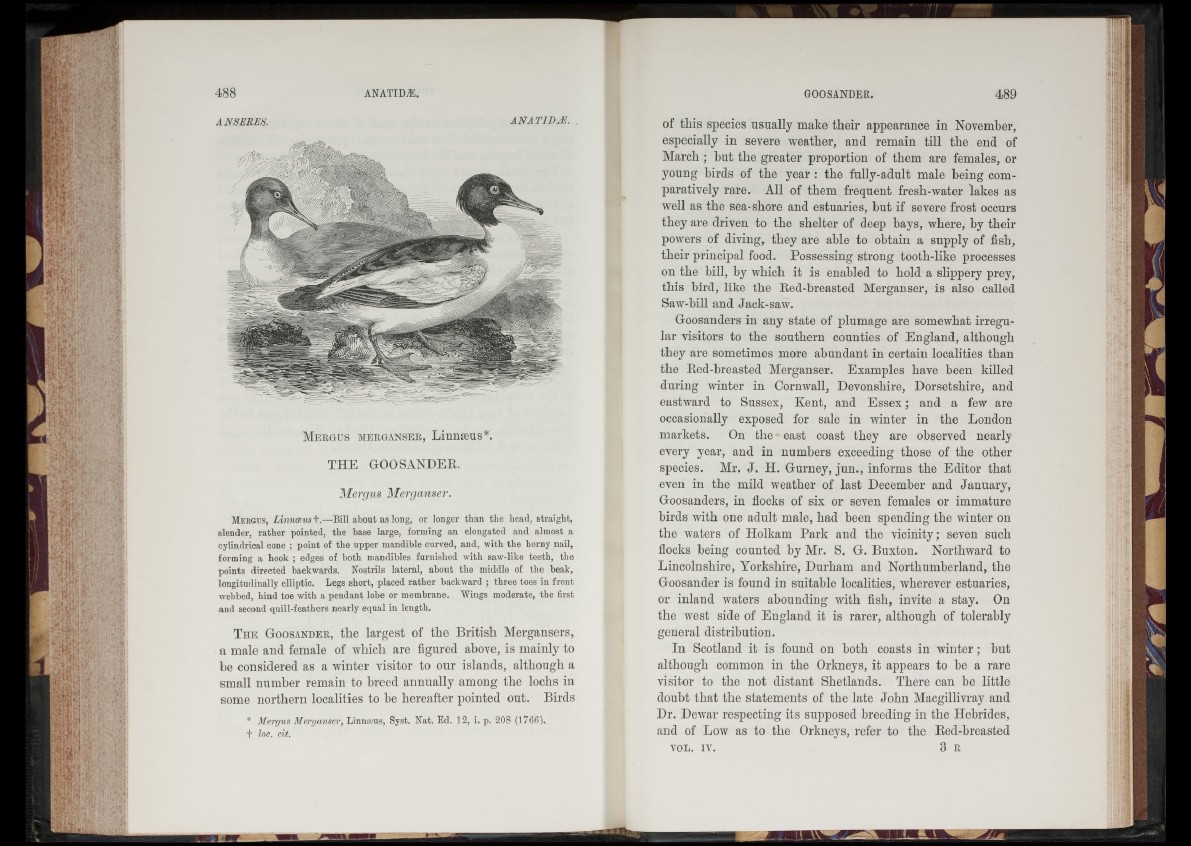
M e r g u s m e r g a n se r , Linnaeus*.
THE GOOSANDER.
Mergus Merganser.
Mergus, Linnceus t .—Bill about as long, or longer than the head, straight,
slender, rather pointed, the base large, forming an elongated and almost a
cylindrical cone ; point of the upper mandible curved, and, with the horny nail,
forming a hook ; edges of both mandibles furnished with saw-like teeth, the
points directed backwards. Nostrils lateral, about the middle of the beak,
longitudinally elliptic. Legs short, placed rather backward ; three toes in front
webbed, hind toe with a pendant lobe or membrane. Wings moderate, the first
and second quill-feathers nearly equal in length.
T h e G oo sa n d er , the largest of the British Mergansers,
a male and female of which are figured above, is mainly to
be considered as a winter visitor to our islands, although a
small number remain to breed annually among the lochs in
some northern localities to he hereafter pointed out. Birds
* Mergus Merganser, Linnaeus, Syst. Nat. Ed. 12, i. p. 208 (1766),
f loc. cit.
of this species usually make their appearance in November,
especially in severe weather, and remain till the end of
March ; hut the greater proportion of them are females, or
young birds of the year : the fully-adult male being comparatively
rare. All of them frequent fresh-water lakes as
well as the sea-shore and estuaries, but if severe frost occurs
they are driven to the shelter of deep hays, where, by their
powers of diving, they are able to obtain a supply of fish,
their principal food. Possessing strong tooth-like processes
on the hill, by which it is enabled to hold a slippery prey,
this bird, like the Red-breasted Merganser, is also called
Saw-bill and Jack-saw.
Goosanders in any state of plumage are somewhat irregular
visitors to the southern counties of England, although
they are sometimes more abundant in certain localities than
the Red-breasted Merganser. Examples have been killed
during winter in Cornwall, Devonshire, Dorsetshire, and
eastward to Sussex, Kent, and Essex; and a few are
occasionally exposed for sale in winter in the London
markets. On the east coast they are observed nearly
every year, and in numbers exceeding those of the other
species. Mr. J. H. Gurney, jun., informs the Editor that
even in the mild weather of last December and January,
Goosanders, in flocks of six or seven females or immature
birds with one adult male, had been spending the winter on
the waters of Holkam Park and the vicinity; seven such
flocks being counted by Mr. S. G. Buxton. Northward to
Lincolnshire, Yorkshire, Durham and Northumberland, the
Goosander is found in suitable localities, wherever estuaries,
or inland waters abounding with fish, invite a stay. On
the west side of England it is rarer, although of tolerably
general distribution.
In Scotland it is found on both coasts in winter; but
although common in the Orkneys, it appears to he a rare
visitor to the not distant Shetlands. There can be little
doubt that the statements of the late John Macgillivray and
Dr. Dewar respecting its supposed breeding in the Hebrides,
and of Low as to the Orkneys, refer to the Red-breasted
VOL. i v . 3 R